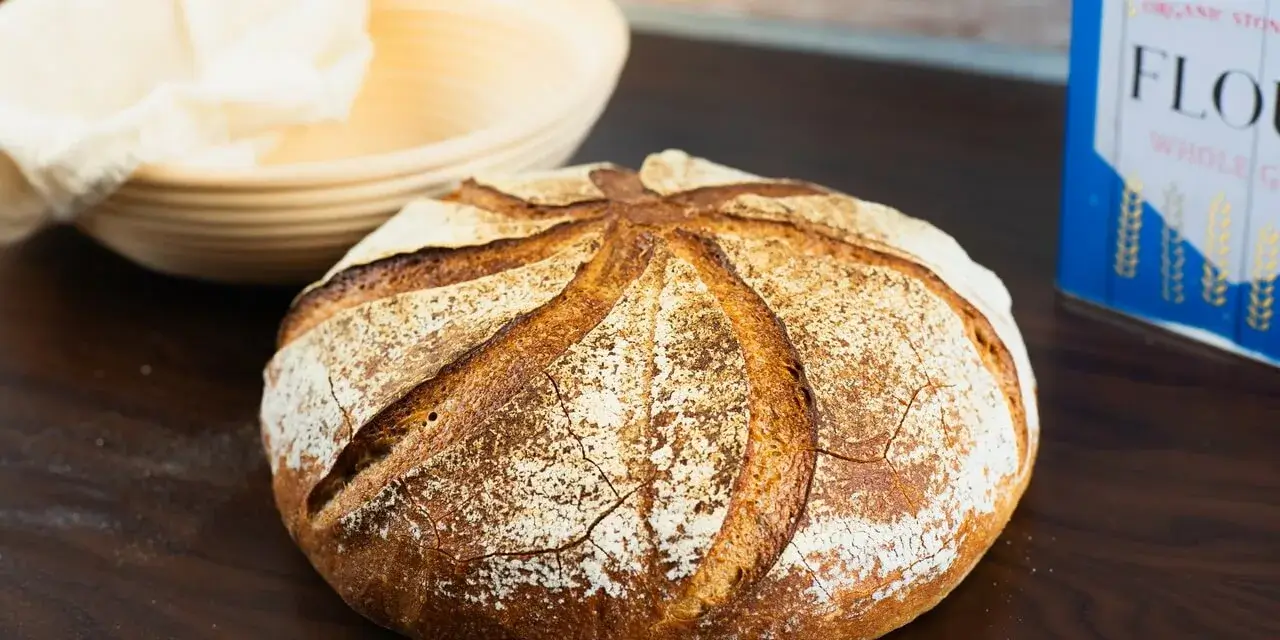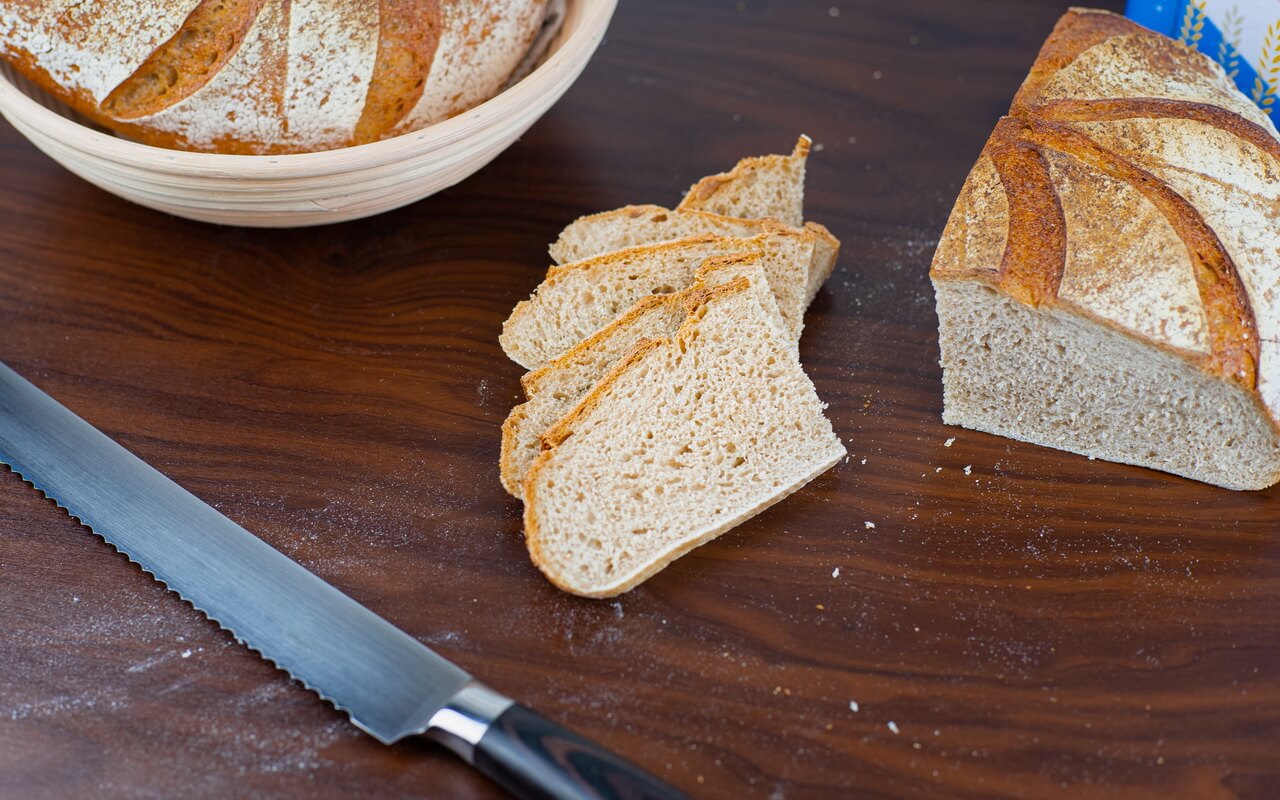As you can probably see on Delight Baking, we really like sourdough bread! So it is time for a nice sourdough bread with 65% hydration.
A good sourdough bread is the base of a good meal, so it is very important to have a variety of recipes so you can choose between them.
This recipe has a low hydration, it is quite easy to handle and and you don’t need any yeast at all, but can use some if your sourdough starter is not that powerfull yet.
As a general rule you can remember: The higher the hydration, the more advanced the handling. Just start with the simpler ones and faster than you expect, you will also be able to handle the more advanced recipes.
Things to know before you start
Time Schedule
| Steps | Work time | Waiting time |
| Mix | ~15 minutes | – |
| Bulk Fermentation, Stretch & Fold | ~20 minutes | 2,5 hours |
| Pre-shape | ~5 minutes | 20 minutes |
| Shape | ~5 minutes | – |
| Proof | – | 10-12 hours |
| Score | ~5 minutes | – |
| Bake | ~5 minutes | 45 minutes |
| Cool | – | 2 hours |
This sourdough bread with 65% hydration will be baked and ready to eat in just about 16 hours.
Total ingredients
| Weight | Ingredient |
| 300 g | Mature sourdough starter – From all-purpose flour |
| 350 g | All-purpose flour |
| 100 g | Rye flour |
| 15 g | Salt |
| 2 g | Yeast – Fresh (optional) |
| 240 g | Water |
You will have a dough of about 1.005 g in total.
Make sure to have a mature sourdough starter that is active and healthy. If you think your starter is not, then you can add 2 g of fresh yeast to help with the rise.
Difficulty
Because of a hydration level of only 65% the dough is pretty easy to handle and therefore this sourdough bread is simple to make.
You can have a look at our sourdough bread for beginners recipe that contains a lot of details for the different steps used here.
Baking tools
You will need a round banneton proofing basket to get the bread in a nice round shape. Also take a look at our should have baking tools to find some more baking tools we are constantly using.
Steps
1. Mix
| Weight | Ingredient |
| 300 g | Mature sourdough starter – From all-purpose flour |
| 350 g | All-purpose flour |
| 100 g | Rye flour |
| 15 g | Salt |
| 2 g | Yeast – Fresh (optional) |
| 240 g | Water – Lukewarm |
- Mix all of the mentioned ingredients in a stand mixer for 5 minutes on speed level one and 7 minutes on speed level two
- The dough should be smooth after mixing and not stick to the bowl a lot
2. Bulk Fermentation, Stretch & Fold
- Cover the dough and let it rest for a total of 2,5 hours at 20-22°C (68-71,6°F)
- During that time stretch & fold the dough every 30 minutes (3 times in total) and after the 3rd time let it ferment further for 1 hour until 2,5 hours in total are reached
- After each stretch and fold put it back to the bowl and cover it again so it doesn’t dry out
3. Pre-shape
- Get the dough in shape by roughly rounding it
- Afterwards look for a dry spot on your surface and flour it
- Transfer the pre-shaped dough ball on the floured surface
- Cover it with a towel and let it rest for 20 minutes
- Tip: If you realize that the dough starts sticking to your hand or bench knife, just clean the bench knife of any dough and flour it again a bit
4. Shape
- Get the dough in the final shape by rounding it again
5. Proof
- Dust your proofing basket with all-purpose flour
- Put your previously shaped dough seam-side-up in the dusted proofing basket
- Add flour on top and cover it with a towel
- Let it proof for 10 to 12 hours in the fridge at 5°C (41°F)
6. SCORE
- Cover a pizza peel with parchment paper
- Take your proofed dough out of the fridge
- Gently take your dough out of the proofing basket by flipping it upside down on the pizza peel
- Make seven crescent shaped cuts (about 2-3 cm deep) on top of the dough by starting in the center and going to the edge with a bread lame
7. Bake
- Preheat oven to 260°C (500°F) for ~45 minutes with the upper and lower heat function
- Put the loaf in the oven, create steam and bake for 45 minutes
- After 10 minutes lower the temperature to 220°C (428°F), let the steam out by slightly opening the oven door for ~45 seconds and close it again
8. Cool
- Let your sourdough bread cool for 2 hours on some kind of grid
Conclusion
Crust
Lovely crunchy crust with a hint of flour.
Crumb
This sourdough bread has a firm crumb with tight and fine pores that don’t tear apart.
Taste
The taste of this bread is nicely balanced and mild with nothing that is dominating too much. The salty and slightly sour taste is classic and delicious.
Goes good with
Whatever you prefer of cold cuts or marmalade and honey. Due to the balanced and classic taste, it can be combined with almost everything.














Hi, very good recipe but it was very salty to my taste. Love your recipes 😋.
Sorry that it was too salty for you, but nice to hear that you love our recipes 🙂
Yehuda, shoot, I just realized the salt is 2.5% I normally do 2% even after their adjustment. Which holy cow, the version of the recipe you tried was 4.2%. Yeah, that would for sure be way too salty. Hopefully, the half of a percent more than my usual won’t be too big of a deal. I’m sure it will be tasty.
Fantastic recipe. I have been using higher hydration recipes which means I could only make a round loaf in a dutch oven (otherwise it’s just too slack to hold any shape despite best effort to create tension. So I was expecting a denser loaf. This had a beautiful open soft crumb. I created steam but would probably spritz with water next time for a slightly prettier crust. Also, I didn’t have enough salt, so was only able to add about 15g (usually only use 10g in a large loaf). Even with reduced salt, It was way too salty so can’t imagine what it would have been like with 25g. Suspect inedible. Other than that…. Super good textured loaf.
Nice to hear that you liked it besides too much salt.
As you are the second one to mention that and therefore we are going to adjust the recipe to use 15 g of salt instead of 25 g.
Goodness, your recipe calls for 66% (300g) starter vs most recipes call for 20%. 65% hydration isn’t 293ml water instead? 😂